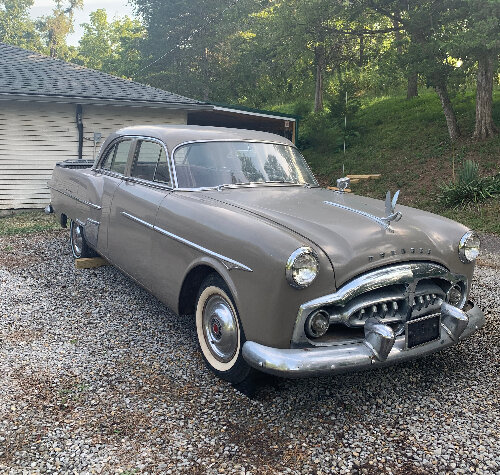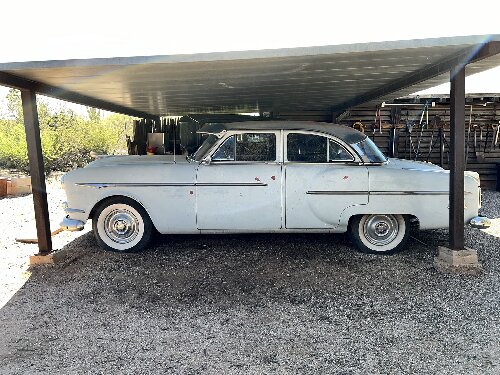|
Re: Powerful 46-47 Supers/Custom Supers
|
||||
|---|---|---|---|---|
|
Home away from home
|
Thanks, sportsfans, but this is a replay of the results i got when i posed the same question on the CCCA Forums. The words of buffs with experience in well-tweaked, modified race and drag cars in the '60s doesn't answer the question. Neither do drag race times, as they're about acceleration, not top speed.
Acceleration = weight/torque/final gearing Absolute speed= coeficient of drag (CD rating)/horsepower/final gearing I'm sure somewhere are documented, written, sanctioned top speeds of the above cars, stock, in the day. Packard47's opening post about the listing of the 1940 Cadillac V-16 being a stretch is absolutely right. Cad V-16 production ceased in December, 1939. Only 61 1940 Cad V-16s were delivered. In fact, just 314 were sold in the flathead V-16's first year, 1938, and a mere 136 in 1939. Cad's final V-16 was strictly an ultimate statement for the marketing panache that'd filter down to lesser GMobiles, an advertising write off. Packard management had a soft laugh when Cadillac's first V-16 debuted for 1930, as it was a vindication of Packard engineering, being a straight eight with the firing impulses halved for less crankpin loading. The Packard and Pierce-Arrow 12s were finer engines. But "16 cylinders" got the public's attention. This wasn't lost on Stutz, who called their sohc inline eight the "SV-16 (single valve)" and their dohc straight 8 the "DV-32." As far as V-16s go, thirty years ago, a poll of SAE engineers included the Marmon, not the Cadillac, 16, among the top 20 internal combustion auto engines of the 20th Century. So much for the 1930s. Now, if we can just unearth some concrete, sanctioned top speed runs of 1940s Buicks and Packards!
Posted on: 2012/2/23 18:52
|
|||
|
||||
|
Re: Powerful 46-47 Supers/Custom Supers
|
||||
|---|---|---|---|---|
|
Home away from home
|
my logic (?) on the 40 160 business coupe or 46-7 super Club sedan as best candidates is that the 40 business coupe is the smallest/lightest 356 (remember that the 41's are bigger) while the Clipper club sedan likely has a lower drag coefficient than the touring sedan
Posted on: 2012/2/24 9:14
|
|||
|
||||
|
Re: Powerful 46-47 Supers/Custom Supers
|
||||
|---|---|---|---|---|
|
Home away from home

|
Hi
Interesting discuss of the comparative merits of '40's engines. While HCC benchmarked with the horsepower ratings, in that era of lower compression engines operating on lower octane fuels, torque was perhaps as valid a standard for comparison. To wit: Pre-War Torque, 1940-41 Statistics 1953 Chilton Flat Rate Manual, Engine Specification Section Packard Twelve...............473 ci.....366 lb/ft @ 1400 rpm Cadillac Sixteen..............431 ci.....324 lb/ft @ 1700 rpm Lincoln K V-12................414 ci.....312 lb/ft @ 1200 rpm Packard 8 160/180..........356 ci.....292 lb/ft @ 1800 rpm Cadillac V-8....................346 ci.....283 lb/ft @ 1700 rpm Chrysler 8......................323 ci.....260 lb/ft @ 1600 rpm LaSalle 50, 52, V-8.........322 ci......---- lb/ft @ ------ rpm Buick 8..........................320 ci.....280 lb/ft @ 2000 rpm Lincoln H V-12................292 ci......235 lb/ft @ 1800 rpm Packard 8 120................282 ci.....225 lb/ft @ 1700 rpm Nash Ambassador 8........261 ci.....200 lb/ft @ 1600 rpm Oldsmobile 90 8..............257 ci.....200 lb/ft @ 2000 rpm Hudson 8.......................254 ci.....198 lb/ft @ 1600 rpm Studebaker President 8...250 ci.....195 lb/ft @ 2000 rpm Buick 40, 50 8................248 ci.....210 lb/ft @ 2000 rpm Pontiac 28, 29, 8............248 ci.....175 lb/ft @ 1600 rpm Note the relatively moderate rpms at which these engine developed maximum torque. And those rpms fall right into the meat of the highway speed driving range, which made those cars with high torque at lower rpms so satisfying to drive. Steve Sorry I couldn't find the LaSalle torque statistics in my sources. Anyone have them?
Posted on: 2012/2/24 19:47
|
|||
|
||||
|
Re: Powerful 46-47 Supers/Custom Supers
|
||||
|---|---|---|---|---|
|
Home away from home
|
Though not particularly powerful, certainly not in the league with the 356, the Nash Ambassador straight eight, with 9 main bearings and dual plug OHV, is considered by many to be one of, if not THE, best straight 8s in any US car of the era. I can't comment on the Duesenberg-Lycoming or the foreigners, Bugatti etc. I was told by Al Prueit that the Dusey was not overly smooth or refined, however powerful it may have been.
Posted on: 2012/3/2 15:12
|
|||
|
56 Clipper Deluxe survivor
|
||||
|
||||
|
Re: Powerful 46-47 Supers/Custom Supers
|
||||
|---|---|---|---|---|
|
Home away from home
|
A good place to look for comparisons of top speeds is the 1950 Mexican Road Race records. A number of Packards, Buicks, Cadillacs, and Lincolns were entered. I will see if I can find something. The 1950 race was for stock sedans.
Posted on: 2012/3/2 16:14
|
|||
|
Fred Puhn

|
||||
|
||||
|
Re: Powerful 46-47 Supers/Custom Supers
|
||||
|---|---|---|---|---|
|
Home away from home
|
Don't know what the price/exclusivity cut off is here, but I know the Dusesenberg SJ was rated around 265hp vs 160hp for the 356 Packard, etc. I'm not sure about torque, but imagine it'd be beyond anything listed on the above chart concerning the more "mundane" makes. I believe it was well known as the fastest US made car on the road as well, at the time, topping out around 125mph.
Posted on: 2012/3/2 17:00
|
|||
|
56 Clipper Deluxe survivor
|
||||
|
||||
|
Re: Powerful 46-47 Supers/Custom Supers
|
||||
|---|---|---|---|---|
|
Home away from home
|
Regarding the Nash twin-ignition, ohv, nine-main-bearing inline 8 mentioned three posts above, some things sound better on paper. Don't know about the earlier, larger version, but the 1935-41 260-ci version of the above Nash engine (the final year '42 didn't have twin ignition), because of its relative shortness, had very small main bearings, which quickly wore and lost oil pressure.
Sometimes, as with the five-main-bearing Packard One-Twenty 282-ci and Hudson five-main 254-ci inline eights, five large mains are better. The 420-ci Duesenberg J elected to go with only five instead of the nine in era Packard, Pierce, Chrysler straight eights, all of which had the same 3 1/2 bore/5-inch stroke, 385 cid. But the Duesenberg's five mains were huge. Off the topic, but often wondered if Fred Duesenberg decided to use only five to reduce friction losses in what was more a performance engine than luxury plant. Don't forget that 10th grade high school dropout former car salesman, stock market marauder E. L. Cord ballyhooed 265hp for the Model J simply as he wanted to advertise "the most powerful car in the world," and at that time, there was an extremely limited-production Mercedes SSK boasting 250hp. DOHC or not, there's only so much you can extract from 5.2:1 compression (5.75:1 optional). Road & Track's John Bond, a degreed engineer, visited the Lycoming plant in 1950, saw the dynamometer reports of four Model J engines, the best of which showed a peak 208 hp. Further afield, but since Monsignor Randerson brought it up, Duesenberg's own test of a Model J gave 116 mph, and that was obviously a well-tweaked example, likely with the 5:75 compression and tallest of the four axles, 3.8:1 (The later 3:1 was ONLY in the Cooper/Gable bobtail speedsters, and Ab Jenskins' Bonneville edition). Maurice Hendry and others in the know cite a real world 105 mph or so for most Model Js in road trim, which makes sense, since each 1931-33 ohv Marmon V-16, with 6.25:1 compression and another 71 cubic inches, 3:78:1 rear end, lapped the Indy brickyard at 105 before delivery, and this was confirmed, not a case of E. L. Cord having dash plaques inscribed with an arbitrary figure just over 100 mph slapped on each 1935-36 Auburn 851-852 boattail speedster. Chrysler Imperials in road trim could hit an honest 95 mph. Period Packards, as we know, suffered from stumpier rear axles, as we know from Col. Vincent's longer legged speedster. The professional and much missed Special Interest Autos (Hemmings Classic Car is not in the same league) did a DriveReport of a 1931-33 Chrysler Imperial years ago entitled "Better Than a Duesy?" Adjust for price, a good question. A longtime Packard collector with experience with all three 385-ci straight eights, said the Pierce had the best manifolding, if he had to pick the best engine. BTW, in 1940, Augie Duesenberg was offering a marine version of the 254-ci Hudson splash-oiled straight 8. I always wondered why Packard sold marine versions only of the 245-ci six and 356-ci Su8, but never the 282-ci One-Twenty engine. A 3M engineer in Texas i bought some parts from for my '40 120 in 1975 told me they were still using Packard 120 engines working 24/7 irrigation pumps down there, governors set at 1800 or 2000 rpm. Meanwhile, the question remains unanswered here as it was when i asked a year or two ago on the CCCA Forum: Does anyone have any observed, AAA- or otherwise sanctioned top speeds for 1940-47 Buick Century/Roadmasters, likely with the rare, no cost optional 3.6:1 "economy" rear axle, and 1940-47 overdrive Packard 160 and their 1942-47 Super Clipper versions? ? ?
Posted on: 2012/3/2 17:15
|
|||
|
||||
|
Re: Powerful 46-47 Supers/Custom Supers
|
||||
|---|---|---|---|---|
|
Home away from home
|
I checked the data in my 1950 Mexican Road Race book. There were 7 Packards entered and all of them failed to finish. I could not find any data on top speeds. Most of the top cars in each leg of the race were Cadillacs, but an Oldsmobile won overall. The 2 Alfa Romeos did very well even though they only had 90hp and a 2.5 liter engine. The Alfa had superior suspension, was lighter, and had great drivers who drove Grand Prix cars in Europe.
I have both a 1950 Packard and a 1948 Alfa Romeo in my collection, so I am very interested in this race. Neither car was designed as a race car, but they did pretty well in this event for sedans.
Posted on: 2012/3/6 15:52
|
|||
|
Fred Puhn

|
||||
|
||||
|
Re: Powerful 46-47 Supers/Custom Supers
|
||||
|---|---|---|---|---|
|
Home away from home
|
Veteran international driver Jean Trevoux campaigned a Delahaye at the first La Carrera Pan Americana in 1950, but for the '51 race, entered a '51 Packard 200 with the optional (for the 200) 327, tho' with four Stromberg carburetors on a log manifold and i'd like to see a picture of that engine bay. Trevoux won the first leg of the race, came in fifth overall.
He campaigned this or a similar Packard through '54, but i don't know the outcome of these later events. Recall reading about the driver/co-driver of a Ferrari America in one of the early '50s runs hitting an eagle at over 100 mph. The huge bird went through the windshield, between the two men, and out the back window. They drove on like nothing happened. You see the crowds hugging the narrow roads in towns and villages, with literally just a couple feet between them and cars traveling 80mph. Whew. Now, one of these days, someone, somewhere, somehow, is going to unearth some sanctioned top speeds of 1940-47 Buicks and Packards.
Posted on: 2012/3/7 5:13
|
|||
|
||||








